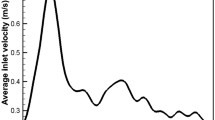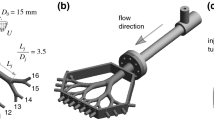Abstract
Angiography is commonly used during endovascular procedures to navigate catheters into a target artery and for evaluation of the arterial luminal geometry. X-ray attenuating contrast material is injected into the arteries and transported into pathologies such as aneurysms or arteriovenous malformations. Images of the transported contrast are used to guide therapeutic decisions. Experience and intuition of the interventionalist are often serving as guide for the injection force, and hence, the speed and volume of the bolus. Forceful injections of small boluses can evoke local turbulence and dispersive mixing in the zone immediately distal to the catheter tip. Turbulence by its nature acts as a strong agitating mechanism such that the bolus of contrast quickly mixes with the flowing blood to occupy the entire lumen so the artery can be visualized. The aims of the present study are (a) to determine the distance from catheter tip beyond which contrast can consider to be fully mixed with the blood during antegrade injection and (b) to determine the thickness of the boundary layer in which contrast concentration is poor, which can contribute to underestimation of vascular diameter using this method. We performed in silico experiments to describe blood and angiographic contrast transport in a straight artery model. The conditions investigated are derived from clinical contrast injection rates typically found in cerebral angiography. A recirculation flow exists in the mixing zone distal to the catheter tip issuing the contrast and convective mixing rather than diffusion is dominating the rapid mixing process. In the vicinity of the arterial wall in the mass transfer boundary layer, however, transport is dominated by molecular diffusion. For lower molecule diffusion coefficient, the mass transfer boundary layer contains a lower concentration of contrast than for a higher molecular diffusion coefficient. These findings imply that contrast visibility near the arterial wall is poor such that arterial dimensions derived from angiograms may be underestimated and consequently sizing of potential implants inaccurate. Outside the mass transfer boundary layer contrast can be considered as fully mixed with the carrying flow in about 10 arterial diameters distal to the injection port.





Similar content being viewed by others
References
Cantrel, L., R. Chaouche, and J. Chopin-Dumas. Diffusion coefficients of molecular iodine in aqueous solutions. J. Chem. Eng. Data 42:216–220, 1997.
Curtet, R. Confined jets and recirculation phenomena with cold air. Combust. Flame 2:383–411, 1958.
Forstall, W., and A. H. Shapiro. Momentum and mass transfer in coaxial gas jets. J. Appl. Mech. Trans. ASME 72:399–408, 1950.
Hinze, J. O. Turbulence (2nd ed.). New York: McGraw-Hill, 1975.
Lieber, B. B., C. Sadasivan, M. J. Gounis, J. Seong, L. Miskolczi, and A. K. Wakhloo. Functional angiography. Crit. Rev. Biomed. Eng. 33(1):1–102, 2005.
Lieber, B. B., C. Sadasivan, Q. Hao, J. Seong, and L. Cesar. The mixability of angiographic contrast with arterial blood. Med. Phys. 36(11):5064–5078, 2009.
Menter, F. R. Two-equation eddy-viscosity turbulence models for engineering applications. AIAA J. 32(8):1598–1605, 1994.
Orth, R. C., M. J. Wallace, and M. D. Kuo. C-arm cone-beam CT: general principles and technical considerations for use in interventional radiology. J. Vasc. Interv. Radiol. 19:814–821, 2008.
Patankar, S. V. Numerical Heat Transfer and Fluid Flow. New York: Taylor & Francis, 1980.
Pope, S. B. Turbulence Flows. Cambridge, UK: Cambridge University Press, 2000.
Razinsky, E., and J. A. Brighton. Confined jet mixing for nonseperating conditions. J. Basic Eng. ASME Publ. 93:333–347, 1971.
Revuelta, A., C. Martinez-Bazan, A. L. Sánchez, and A. Liñán. Laminar Craya–Curtet jets. Phys. Fluids. 16:208–211, 2004.
Shapiro, A. H. An investigation of ejector design by analysis and experiment—discussion. J. Appl. Mech. 18(1):117, 1951.
Strahle, W. C., and S. G. Lekoudis. Evaluation of data on simple turbulent reacting flows. AFOSR TR-85-0880, 1985.
Tenekes, H., and J. L. Lumley. A First Course in Turbulence. Cambridge, MA: MIT Press, 1972.
Varghese, S. S., and S. H. Frankel. Numerical modeling of pulsatile turbulent flow in stenotic vessels. J. Biomech. Eng. 125(4):445–460, 2003.
Wilcox, D. C. Turbulence Modeling for CFD (3rd ed.). La Canada, CA: DCW Industries Inc., 2006.
Acknowledgments
This study was supported by NIH Grant No. R01 NS045753-05A1 to B.B.L.
Author information
Authors and Affiliations
Corresponding author
Additional information
Associate Editor Keefe B. Manning oversaw the review of this article.
Rights and permissions
About this article
Cite this article
Hao, Q., Lieber, B.B. Dispersive Transport of Angiographic Contrast During Antegrade Arterial Injection. Cardiovasc Eng Tech 3, 171–178 (2012). https://doi.org/10.1007/s13239-012-0090-x
Received:
Accepted:
Published:
Issue Date:
DOI: https://doi.org/10.1007/s13239-012-0090-x




